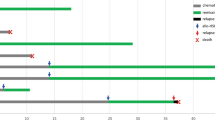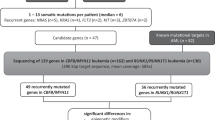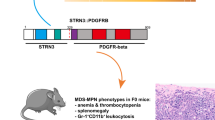Abstract
Three adult patients with de novo acute myeloid leukemia of distinct subtypes harboring t(11;12)(p15;q13) have been investigated to characterize the genes involved in that translocation. Through molecular cytogenetics, a chromosome break was detected at the 3′ part of nucleoporin 98 (NUP98) gene at 11p15. Using rapid amplification of cDNA end, we identified the partner gene at 12q13, HOXC11. Molecular analysis showed that exon 12 of NUP98 was fused in-frame to exon 2 of HOXC11 in all three cases with t(11;12)(p15;q13). Therefore, this type of fusion may represent the major form of the NUP98-HOXC11 chimera so far reported. Moreover, two out of three cases had a confirmed deletion of the 3′ part of NUP98 gene and more telomeric region of 11p harboring a group of tumor-suppressor genes. Interestingly, the NUP98-HOXC11 protein when assayed in a GAL4 reporter system, showed an aberrant trans-regulatory activity as compared to the wild-type HOXC11 in both COS-7 and HL-60 cells. Therefore, NUP98-HOXC11 may contribute to the leukemogenesis by interfering with the cellular mechanism of transcriptional regulation.
This is a preview of subscription content, access via your institution
Access options
Subscribe to this journal
Receive 12 print issues and online access
$259.00 per year
only $21.58 per issue
Buy this article
- Purchase on Springer Link
- Instant access to full article PDF
Prices may be subject to local taxes which are calculated during checkout




Similar content being viewed by others
References
Radu A, Moore MS, Blobel G . The peptide repeat domain of nucleoporin Nup98 functions as a docking site in transport across the nuclear pore complex. Cell 1995; 81: 215–222.
Powers MA, Forbes DJ, Dahlberg JE, Lund E . The vertebrate GLFG nucleoporin, Nup98, is an essential component of multiple RNA export pathways. J Cell Biol 1997; 136: 241–250.
Lam DH, Aplan PD . NUP98 gene fusions in hematologic malignancies. Leukemia 2001; 15: 1689–1695.
Nakamura T, Largaespada DA, Lee MP, Johnson LA, Ohyashiki K, Toyama K et al. Fusion of the nucleoporin gene NUP98 to HOXA9 by the chromosome translocation t(7;11)(p15;p15) in human myeloid leukaemia. Nat Genet 1996; 12: 154–158.
Arai Y, Hosoda F, Kobayashi H, Arai K, Hayashi Y, Kamada N et al. The inv(11)(p15q22) chromosome translocation of de novo and therapy-related myeloid malignancies results in fusion of the nucleoporin gene, NUP98, with the putative RNA helicase gene, DDX10. Blood 1997; 89: 3936–3944.
Raza-Egilmez SZ, Jani-Sait SN, Grossi M, Higgins MJ, Shows TB, Aplan PD . NUP98-HOXD13 gene fusion in therapy-related acute myelogenous leukemia. Cancer Res 1998; 58: 4269–4273.
Nakamura T, Yamazaki Y, Hatano Y, Miura I . NUP98 is fused to PMX1 homeobox gene in human. Blood 1999; 94: 741–747.
Hussey DJ, Nicola M, Moore S, Peters GB, Dobrovic A . The (4;11)(q21;p15) translocation fuses the NUP98 and RAP1GDS1 genes and is recurrent in T-cell acute lymphocytic leukemia. Blood 1999; 94: 2072–2079.
Ahuja HG, Felix CA, Aplan PD . The t(11;20)(p15;q11) chromosomal translocation associated with therapy-related myelodysplastic syndrome results in an NUP98-TOP1 fusion. Blood 1999; 94: 3258–3261.
Ahuja HG, Hong J, Aplan PD, Tcheurekdjian L, Forman SJ, Slovak ML . t(9;11)(p22;p15) in acute myeloid leukemia results in a fusion between NUP98 and the gene encoding transcriptional coactivators p52 and p75-lens epithelium-derived growth factor (LEDGF). Cancer Res 2000; 60: 6227–6229.
Jaju RJ, Fidler C, Haas OA, Strickson AJ, Watkins F, Clark K et al. A novel gene, NSD1, is fused to NUP98 in the t(5;11)(q35;p155) in de novo childhood acute myeloid leukemia. Blood 2001; 98: 1264–1267.
Taketani T, Taki T, Shibuya N, Ito E, Kitazawa J, Terui K et al. The HOXD11 gene is fused to the NUP98 gene in acute myeloid leukemia with t(2;11)(q31;p15). Cancer Res 2002; 62: 33–37.
Suzuki A, Ito Y, Sashida G, Honda S, Katagiri T, Fujino T et al. t(7;11)(p15;p15) Chronic myeloid leukaemia developed into blastic transformation showing a novel NUP98/HOXA11 fusion. Br J Haematol 2002; 116: 170–172.
Rosati R, La Starza R, Veronese A, Aventin A, Schwienbacher C, Vallespi T et al. NUP98 is fused to the NSD3 gene in acute myeloid leukemia associated with t(8;11)(p11.2;p15). Blood 2002; 99: 3857–3860.
Taketani T, Taki T, Ono R, Kobayashi Y, Ida K, Hayashi Y . The chromosome translocation t(7;11)(p15;p15) in acute myeloid leukemia results in fusion of the NUP98 gene with a HOXA cluster gene, HOXA13, but not HOXA9. Genes Chromosomes Cancer 2002; 34: 437–443.
Taketani T, Taki T, Shibuya N, Kikuchi A, Hanada R, Hayashi Y . Novel NUP98-HOXC11 fusion gene resulted from a chromosomal break within exon 1 of HOXC11 in acute myeloid leukemia with t(11;12)(p15;q13). Cancer Res 2002; 62: 4571–4574.
Panagopoulos I, Isaksson M, Billstrom R, Strombeck B, Mitelman F, Johansson B . Fusion of the NUP98 gene and the homeobox gene HOXC13 in acute myeloid leukemia with t(11;12)(p15;q13). Genes Chromosomes Cancer 2003; 36: 107–112.
McGinnis W, Krumlauf R . Homeobox genes and axial patterning. Cell. 1992; 68: 283–302.
Lawrence HJ, Largman C . Homeobox genes in normal hematopoiesis and leukemia. Blood 1992; 80: 2445–2453.
Gregory PA, Mackenzie PI . The homeodomain Pbx2-Prep1 complex modulates hepatocyte nuclear factor 1 alpha-mediated activation of the UDP-glucuronosyltransferase 2B17 gene. Mol Pharmacol 2002; 62: 154–161.
Bai ST, Shi XM, Yang XL, Cao X . Smad6 as a transcriptional corepressor. J Biol Chem 2000; 275: 8267–8270.
Asahara H, Dutta S, Kao HY, Evans RM, Montminy M . Pbx-Hox heterodimers recruit coactivator–corepressor complexes in an isoform-specific manner. Mol Cell Biol 1999; 19: 8219–8225.
Passner JM, Ryoo HD, Shen L, Mann RS, Aggarwal AK . Structure of a DNA-bound ultrabithorax–extradenticle homeodomain complex. Nature 1999; 397: 714–719.
Wong KF, Kwong YL, So CC . De novo AML with trilineage myelodysplasia and a novel t(11;12)(p15;q13). Cancer Genet Cytogenet 1998; 100: 49–51.
World Health Organization classification of tumours. In: Jatte ES, Harris NL, Stein H, Vardiman JW (eds). Pathology and Genetics of Tumours of Haematopoietic and Lymphoid Tissues. Lyon: IARC Press 2001.
Argani P, Antonescu CR, Illei PB, Lui MY, Timmons CF, Newbury R et al. Primary renal neoplasms with the ASPL-TFE3 gene fusion of alveolar soft part sarcoma: a distinctive tumor entity previously included among renal cell carcinomas of children and adolescents. Am J Pathol 2001; 159: 179–192.
Ladanyi M, Lui MY, Antonescu CR, Krause-Boehm A, Meindl A, Argani P et al. The der(17)t(X;17)(p11;q25) of human alveolar soft part sarcoma fuses the TFE3 transcription factor gene to ASPL, a novel gene at 17q25. Oncogene 2001; 20: 48–57.
Sidhar SK, Clark J, Gill S, Hamoudi R, Crew AJ, Gwilliam R et al. The t(X;1)(p11.2;q21.2) translocation in papillary renal cell carcinoma fuses a novel gene PRCC to the TFE3 transcription factor gene. Hum Mol Genet 1996; 5: 1333–1338.
Weterman MA, Wilbrink M, Geurts van Kessel A . Fusion of the transcription factor TFE3 gene to a novel gene PRCC in t(X;1)(p11;q21)-positive papillary renal cell carcinomas. Proc Natl Acad Sci USA; 93: 15294–15298.
Shen WF, Krishnan K, Lawrence HJ, Largman C . The HOX homeodomain proteins block CBP histone acetyltransferase activity. Mol Cell Biol 2001; 21: 7509–7522.
Saleh M, Rambaldi I, Yang XJ, Featherstone MS . Cell signaling switches HOX-PBX complexes from repressors to activators of transcription mediated by histone deacetylases and histone acetyltransferases. Mol Cell Biol 2000; 20: 8623–8633.
Sur IP, Toftgard R . Repression of transcription by HoxC11 upon phorbol ester stimulation. Mol Cell Biol Res Commun 2000; 3: 367–373.
Owens BM, Hawley RG . HOX and non-HOX homeobox genes in leukemic hematopoiesis. Stem Cells 2002; 20: 364–379.
Bijl JJ, van Oostveen JW, Walboomers JM, Horstman A, van den Brule AJ, Willemze R et al. HOXC4, HOXC5, and HOXC6 expression in non-Hodgkin's lymphoma: preferential expression of the HOXC5 gene in primary cutaneous anaplastic T-cell and oro-gastrointestinal tract mucosa-associated B-cell lymphomas. Blood 1997; 90: 4116–4125.
Papenbrock T, Visconti RP, Awgulewitsch A . Loss of fibula in mice overexpressing Hoxc11. Mech Dev 2000; 92: 113–123.
Calvo KR, Sykes DB, Pasillas MP, Kamps MP . Nup98-HoxA9 immortalizes myeloid progenitors enforces expression of Hoxa9, Hoxa7 and Meis1, and alters cytokine-specific responses in a manner similar to that induced by retroviral co-expression of Hoxa9 and Meis1. Oncogene 2002; 21: 4247–4256.
Kasper LH, Brindle PK, Schnabel CA, Pritchard CE, Cleary ML,, van Deursen JM . CREB binding protein interacts with nucleoporin-specific FG repeats that activate transcription and mediate NUP98-HOXA9 oncogenicity. Mol Cell Biol 1999; 19: 764–776.
Acknowledgements
This work was supported in part by the National Key Program for Basic Research (973), National High Tech Program (863), National Natural Science Foundation of China, Shanghai Municipal Commission for Science and Technology, Shanghai Municipal Commission for Education and the Clyde Wu Foundation of SIH. We thank all members of the SIH and SKLMG for their support.
Author information
Authors and Affiliations
Rights and permissions
About this article
Cite this article
Gu, BW., Wang, Q., Wang, JM. et al. Major form of NUP98/HOXC11 fusion in adult AML with t(11;12)(p15;q13) translocation exhibits aberrant trans-regulatory activity. Leukemia 17, 1858–1864 (2003). https://doi.org/10.1038/sj.leu.2403036
Received:
Accepted:
Published:
Issue Date:
DOI: https://doi.org/10.1038/sj.leu.2403036
Keywords
This article is cited by
-
HOXC11 drives lung adenocarcinoma progression through transcriptional regulation of SPHK1
Cell Death & Disease (2023)
-
A new fusion gene NUP98-IQCG identified in an acute T-lymphoid/myeloid leukemia with a t(3;11)(q29q13;p15)del(3)(q29) translocation
Oncogene (2008)
-
Hornerin gene was involved in a case of acute myeloid leukemia transformed from myelodysplastic syndrome with t(1;2)(q21;q37)
Leukemia (2006)
-
NUP98 rearrangements in hematopoietic malignancies: a study of the Groupe Francophone de Cytogénétique Hématologique
Leukemia (2006)



